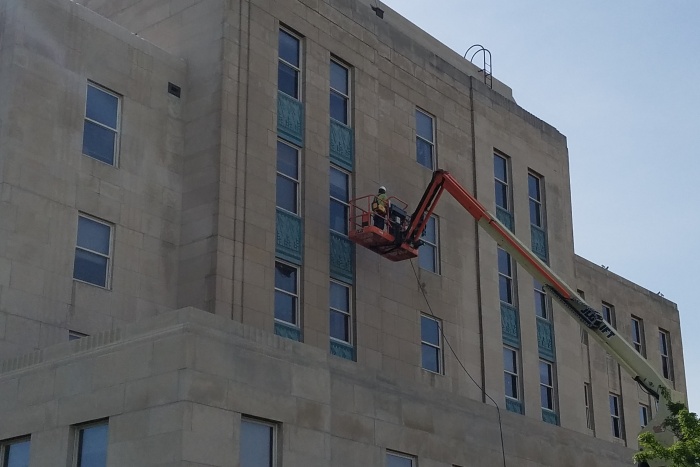All matter breaks down over time. The structures that surround us today are no exception to that law of physics. Some building materials are more durable than others, like stone and steel, but unfortunately the days of structures surviving thousands of years, like the Egyptian pyramids and Roman cathedrals, are over. This is why proactive building maintenance is a must.
Most structures erected today have a life expectancy of less than 100 years, with each building component designed to work for a designated period before requiring maintenance or replacement. Therefore, preventive maintenance of building exteriors has become more important than ever.
“Preventative maintenance and building inspections aim to reduce the frequency and scale of maintenance projects. While buildings have a finite lifespan, the goal is to invest in repairs that prevent major, costly issues. It’s about identifying the current condition of your building components and allocating your budget strategically to forestall significant repairs,” said Western Specialty Contractors Region Manager Jim Rechtin, Jr. “Some managers react to maintenance problems after they occur, flying blind without knowledge of their building components’ condition. Smart managers, armed with a proper maintenance plan, can still face emergency repairs, but proactive building inspections make such occurrences infrequent. The key is to get a clear understanding of your building’s condition, anticipating issues before they become emergencies.”
How extensive a building’s preventative maintenance program needs to be will depend directly on the size of the building, number of different materials and components, geographic location and available maintenance personnel.
Essential parts of a maintenance program
A preventive maintenance program generally consists of two major parts – the inspection and the execution. During inspection of a building’s exterior, some of the more complex structures may require special access and assistance from a contractor, however, for most structures an in-house maintenance crew – with a little bit of training – is capable of doing the job.
“When performing the inspection, it is extremely important to document the findings and keep them in a consistent format from year to year. This can be achieved by simply using a three-ring binder with notes and pictures or a multi-layered spreadsheet. It is also necessary to inspect any work that has recently been performed as those repairs may still be under warranty,” said Rechtin, Jr.
Some specific items to inspect and document regarding a building’s exterior condition include:
- Gutters, drains, downspouts, drainage, roof – Decaying leaves, pine needles and dirt run-off can all contribute to ponding water and clogged gutters and downspouts, which is why it is essential that all roof drains remain clear of obstructions. In addition to the risk of water pouring into the tenant spaces should a breach in the roof occur, the freezing and thawing of ponding water during the fall and winter months can cause extensive roof damage.
- Perimeters of doors, windows and other wall penetrators – The exterior walls of a building can be a significant source of unwanted water leakage. Commercial building walls require many openings for plumbing, irrigation connections, lighting, HVAC system elements, exhaust vents, air intakes, joints around windows and doors, and fire alarms, to name a few. Unplanned holes may also be present caused by aging brick joints that need re-pointing, vanishing sealants, damage from acid rain and settling cracks.
- Building control and expansion joints – Like any other element of a structure, its controls and expansion joints can become damaged. Evidence of damage includes warping, cracking, leaking water, loosening screws and building settlement or moving.
- Walking/driving surfaces – When water infiltrates concrete, it can freeze, causing the water to occupy nine percent more volume than in its liquid state. This expansion causes distress on the concrete, which can lead to fractures that will continue to grow exponentially as saturation of the material increases. Cracks, spalls, rust spots, deterioration, pot-holes and heaves are all signs of damage.
- Copings and flashings – When surveying the roof, be sure to inspect the copings and flashings. Water damage to exterior and interior walls can be significant if you do not maintain these important elements properly.
Executing a proactive building maintenance program
The second part of any preventive maintenance program is the execution. You should put the data collected during the inspection into a budget for needed repairs. Depending on the condition of the structure, prioritization is essential for repairs. It is also important to evaluate the need for protective measures such as sealers or coatings. A specialty contractor with experience in facade maintenance and restoration, such as Western Specialty Contractors, can itemize each inspection item and offer specific recommendations for repairs.
“If you are in charge of a structure that does not have a preventive maintenance program in place for its exterior, you should think about implementing one immediately,” said Rechtin, Jr. “Preventive maintenance keeps the building off of the deferred maintenance path, which usually results in exponential restoration costs. A maintenance plan will prevent structural failures and promote safer structures, plus a well-maintained exterior helps to attract and keep tenants. Preventive maintenance for any structure’s exterior is a must.”













